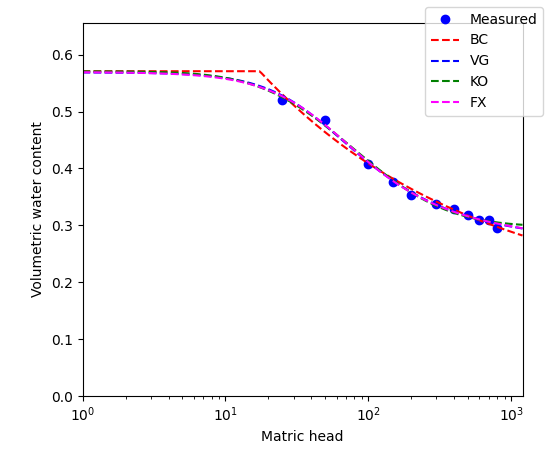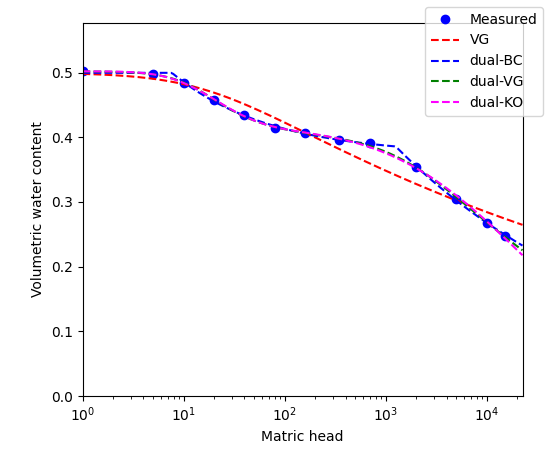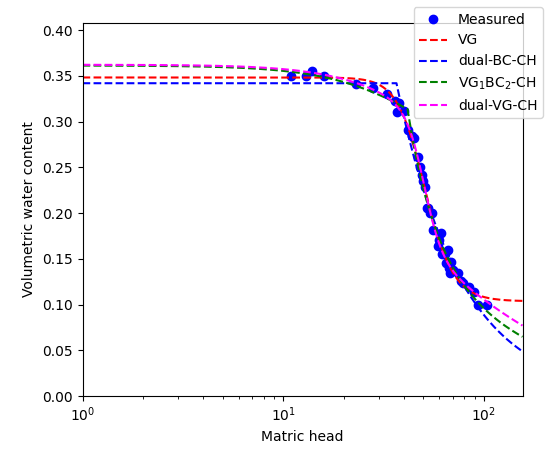
[ English | 日本語 ]
Soil water retention curve (SWRC) is described by water retention function θ(h) is a function of volumetric water content, θ to pressure head, h. Here we denote h to be positive for unsaturated conditions, thus considering to be an equivalent suction. Effective water content Se is defined by \(S_e = \frac{\theta-\theta_r}{\theta_s-\theta_r}\), where saturated water content θs and residual water content θr are parameters either treated as constant or variable. We can obtain θ(h) from Se(h) by θ(h) = (θs - θr)Se(h) + θr
SWRC Fit simultaneously fits measured SWRC data to multiple Se(h) functions described as follows and determine the parameters of the functions.
| Abbr. | Model | Equation | Parameters |
| BC | Brooks and Corey | \(S_e = \begin{cases}\left(h / h_b\right)^{-\lambda} & (h>h_b) \\ 1 & (h \le h_b)\end{cases}\) | θs θr, hb, λ |
| VG | van Genuchten | \(S_e = \biggl[\dfrac{1}{1+(\alpha h)^n}\biggr]^m ~~ (m=1-1/n)\) | θs θr, α, n |
| KO | Kosugi | \(\begin{eqnarray}S_e &=& Q \biggl[\dfrac{\ln(h/h_m)}{\sigma}\biggr]\\Q(x) &=& \mathrm{erfc}(x/\sqrt{2})/2\end{eqnarray}\) | θs θr, hm, σ |
| FX | Fredlund and Xing | \(S_e = \biggl[ \dfrac{1}{\ln \left[e+(h / a)^n \right]} \biggr]^m\) | θs θr, a, m, n |
Here is SWRC for the sample data, clay loam (UNSODA 3033) with unimodal models, with all variables including θs and θr are optimized. Fitted parameters, coefficient of determination (R2) and AIC can be shown in table by executing calculation with SWRC Fit.

Multimodal water retention function is defined as a linear superposition of subfunctions Si(h) as follows (Seki et al., 2022). \[ S(h) = \Sigma_{i=1}^k w_i S_i(h) \] where k is the number of subfunctions, and wi are weighting factors with 0<wi<1 and Σwi = 1. Unimodal models are k=1, and bimodal models are k=2.
The multimoodal model is denoted by subscripting the number of the subfunction. For example, VG1BC2 model denotes VG subfunction for S1(h) and BC subfunction for S2(h). Combinations of the same subfunctions (e.g., BC1BC2BC3...) are referred to as the multimodels (e.g., multi-BC). The multi-VG model is the same as Durner (1994) model, and multi-KO model is the same as Seki (2007) model. Multimodels consisting of only two similar subfunctions are referred to as dual-models, such as the dual-BC for BC1BC2.
As explained in the previous section, there are some possible combinations of bimodal models, where following models are implemented in SWRC Fit.
| Model | Equation | Parameters |
| dual-BC | \(S_e = \begin{cases}w_1 \left(h / h_{b_1}\right)^{-\lambda_1} + (1-w_1)\left(h / h_{b_2}\right)^{-\lambda_2} & (h>h_{b_2}) \\ w_1 \left(h / h_{b_1}\right)^{-\lambda_1} + 1-w_1 & (h_{b_1} < h \le h_{b_2}) \\1 & (h \le h_{b_1})\end{cases}\)< d>θs θr, w1, hb1, λ1, hb2, λ2 | |
| dual-VG | \(\begin{eqnarray}S_e &=& w_1\bigl[1+(\alpha_1 h)^{n_1}\bigr]^{-m_1} + (1-w_1)\bigl[1+(\alpha_2 h)^{n_2}\bigr]^{-m_2}\\m_i&=&1-1/{n_i}\end{eqnarray}\)< d>θs θr, w1, α1, n1, α2, n2 | |
| dual-KO | \(\begin{eqnarray}S_e &=& w_1 Q \biggl[\dfrac{\ln(h/h_{m_1})}{\sigma_1}\biggr] + (1-w_1) Q \biggl[\dfrac{\ln(h/h_{m_2})}{\sigma_2}\biggr]\\Q(x) &=& \mathrm{erfc}(x/\sqrt{2})/2\end{eqnarray}\)< d>θs θr, w1, hm1, σ1, hm2, σ2 |
Here is SWRC for the sample data, silty loam (UNSODA 2760) with bimodal models and VG model for comparison. Fixed parameter θr = 0 is used for bimodal models, while all variables are optimized for VG model.

See also Figure 1 in Seki et al., 2022.
CH (common head) variation for multimodal model of BC, VG, KO subfunctions is defined in Seki et al. (2022) as \[H = h_{b_i} = \alpha_i^{-1} = h_{m_i} \] where following models are implemented in SWRC Fit.
| Model | Equation | Parameters |
| dual-BC-CH | \(S_e = \begin{cases}w_1 \left(h / h_b\right)^{-\lambda_1} + (1-w_1)\left(h / h_b\right)^{-\lambda_2} & (h>h_b)\\ 1 & (h \le h_b)\end{cases}\)< d>θs θr, w1, hb, λ1, λ2 | |
| VG1BC2-CH | \(\begin{eqnarray}S_e &=& \begin{cases}w_1 S_1 + (1-w_1)\left(h/H\right)^{-\lambda_2} & (h>H)\\ w_1 S_1 + 1-w_1 & (h \le H)\end{cases}\\S_1 &=& \bigl[1+(h/H)^{n_1}\bigr]^{-{m_1}} ~~ (m_1=1-1/{n_1})\end{eqnarray}\)< d>θs θr, w1, H, n1, λ2 | |
| dual-VG-CH | \(\begin{eqnarray}S_e &=& w_1\bigl[1+(\alpha h)^{n_1}\bigr]^{-m_1} + (1-w_1)\bigl[1+(\alpha h)^{n_2}\bigr]^{-m_2}\\m_i&=&1-1/{n_i}\end{eqnarray}\)< d>θs θr, w1, α, n1, n2 | |
| KO1BC2-CH | \(\begin{eqnarray}S_e &=& \begin{cases}w_1 S_1 + (1-w_1)\left(h/H\right)^{-\lambda_2} & (h>H)\\ w_1 S_1 + 1-w_1 & (h \le H)\end{cases}\\S_1 &=& Q \biggl[\dfrac{\ln(h/h_m)}{\sigma_1}\biggr], Q(x) = \mathrm{erfc}(x/\sqrt{2})/2\end{eqnarray}\)< d>θs θr, w1, H, σ1, λ2 |
Here is SWRC for the sample data, sand (UNSODA 4440) with CH variations of bimodal models and VG model for comparison. Fixed parameter θr = 0 is used for bimodal models, while all variables are optimized for VG model. θr is optimized at 0.074 for VG model.

See also Figure 2 in Seki et al., 2022.
For water retention functions except for FX model, closed-form hydraulic conductivity equations with generalized Mualem's equation are available (Seki et al., 2022). The equations are useful for practical applications as shown in Seki et al. (2023). Use unsatfit for fitting with those functions.
In the old version of SWRC Fit, KO model was denoted as LN model, dual-VG model was denoted as DB model, and dual-KO was denoted as BL model. The notation was changed to match Seki et al. (2022).
Persistent URL of this page is http://purl.org/net/swrc/model.html.
Author: Katsutoshi Seki